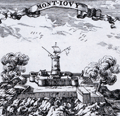| | Thumbnail | | Creator | Date | Title / Author / Date / Location | Price | | | Description |
| 4698 |  | Details | Pontault, Sébastien Beaulieu de | 1678 |
| Antique view of Montjuïc at Barcelona, Spain |
|
Pontault, Sébastien Beaulieu de |
|
| 1678 |
| LOC:13 |
| $225.00 | Pontault--Sébastien-Beaulieu-de | Antique-view-of-Montjuïc-at-Barcelona--Spain | Antique view of Montjuïc, a broad, low hill in Barcelona, Catalonia, Spain to the west of the old quarter. The top of Montjuïc (Castell de Montjuic) at about 550' is the site of several fortifications dating from the 17th century. These served as a prison, often holding political prisoners, until the time of General Franco.
<br></br>
Here, cannon are shown firing from the Castell while a marine semaphore atop a tall tower relays signals to nearby vessels. Montjuïc became a key element in the defence of Barcelona. By controlling the mountain and its communication with the rest of the city, the defenders of Barcelona could keep attacking troops further from the eastern perimeter of the city walls and the coastline.
<br></br>
This antique copper engraving is from <b>Pontault de Beaulieu's</b> "Plans et profils des villes des Pays-Bas, Lorraine, Alsace, Catalogne et Franche-Comté".
<br></br>
According to the Atlas de Barcelona
<div class="indenttextblock"> Beaulieu drew the part of the small fort built during the Reapers’ War – which he might have known – and hints at the citadel which should surround it, in what could be considered to be a “future project”. French interest in the strategic Catalonian capital meant that even Beaulieu drew what could be the defenses of Barcelona. The French National Library keeps an ink drawing that Beaulieu himself drew of the layout of Montjuïc castle with the same framing as the engraving. (http://www.atlesdebarcelona.cat/gravats/comments/38-beaulieu-sebastien-de-pontault-de/). </div> |
| 4699 |  | Details | Pontault, Sébastien Beaulieu de | 1678 |
| Antique view of the citadel on Montjuïc at Barcelona, Spain |
|
Pontault, Sébastien Beaulieu de |
|
| 1678 |
| LOC:13 |
| $185.00 | Pontault--Sébastien-Beaulieu-de | Antique-view-of-the-citadel-on-Montjuïc-at-Barcelona--Spain | Antique view of the fort or citadel at Montjuïc, a broad, low hill in Barcelona, Catalonia, Spain to the west of the old quarter. The top of Montjuïc (Castell de Montjuic) at about 550' is the site of several fortifications dating from the 17th century. The steep and rocky sides of Montjuic are apparent where the land meets the Mediterranean Sea.
<br></br>
In a key to the upper right, five important entrances and fortifications at the citadel are identified.
<br></br>
According to the Atlas de Barcelona
<div class="indenttextblock"> Beaulieu drew the part of the small fort built during the Reapers’ War – which he might have known – and hints at the citadel which should surround it, in what could be considered to be a “future project”. French interest in the strategic Catalonian capital meant that even Beaulieu drew what could be the defenses of Barcelona. The French National Library keeps an ink drawing that Beaulieu himself drew of the layout of Montjuïc castle with the same framing as the engraving. (http://www.atlesdebarcelona.cat/gravats/comments/38-beaulieu-sebastien-de-pontault-de/). </div> |
| 457 |  | Details | Pontault, Sébastien Beaulieu de | 1694 |
| Combat Naval 1645 |
|
Pontault, Sébastien Beaulieu de |
|
| 1694 |
| LOC:0 |
| $0.00 | Pontault--Sébastien-Beaulieu-de | Combat-Naval-1645 | SOLD
<BR> </BR>
Interesting, scarce depiction of the "Action of 28 September 1644" when six Maltese galleys (galère / pl. galères; Fr.) attacked and defeated several sailing vessels of the Ottoman Sultan. This attractive original copperplate engraving contains an elaborate border and garland wrapped with ribbons and a central portrait of Gabrielle Chambres de Boisbaudran, the leader of the Maltese contingent and a Knight of Malta, who was killed in that engagement. From Paris, 1694.
<BR> </BR>
The engraved battle scene includes the island of Rhodes, Greece in the distance as Christian galleys engage with Greek and Turkish square-rigged sailing vessels. The six galleys depicted include" "La Capitaine de Malte, St. Jean, St. Laurent, St. Joseph, Ste. Marie, and La Victoire.
<BR> </BR>
The Christian galleys engaged a Ottoman convoy carrying pilgrims bound for Mecca. The Maltese killed many pilgrims and took almost 400 prisoners as slaves including by some reports one of the Sultan's wives and her son. On their voyage home the Maltese stopped in Crete, then a possession of Venice, for a few days. This apparent collusion between the Maltese and Venetians, previously at peace with the Turks, served as a pretense for the Cretan war between the Ottomans, Venice and Malta between 1645 and 1669.
<BR> </BR>
From the book "Les glorieuses Conquêtes de Louis-le-Grand: ou Recueil, de Plans et Vues des places assiegeés, et de celles ou se sont douneés des batailles…" produced from the drawings of the Sébastien Pontault de Beaulieu (1612-1674). Pontault, a French engineer, is considered to have been the inventor of the art of military topography. |